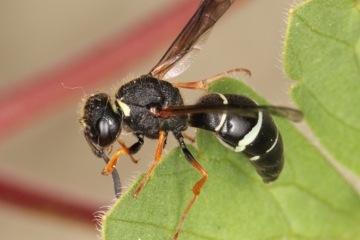Species Account for Odynerus melanocephalus
Odynerus melanocephalus (Gmelin in Linnaeus, 1790)
Black Headed Mason Wasp
Aculeata: Eumenidae

Reproduction for study and non-profit use permitted, all other rights reserved.
Taxonomic group: bees and wasps (Aculeata) - County data
View time series maps for Odynerus melanocephalus
member log-on for taxon report
Status: Na;Section 41 Priority Species
Essex RDB: Listed
Threat: Regionally Important
Images
upload a new image
Species text
Odynerus melanocephalus has been widely recorded in southern England, but post-1970 records are mostly from the coasts of Dorset, Kent, the Isle of Wight and the East Thames Corridor. The species is a new UKBAP species, added in the 2007 review. It is especially associated with grassland and scrub on light, clayish soils, and has been found on soft rock cliffs and inland on heaths and disturbed areas. Nest burrows, with the protruding chimney characteristic of Odynerus species, are dug in level, exposed soil. Although the 1991 status review suggests that the nest cells are stocked with small larvae of Lepidoptera or Coleoptera, autecological work undertaken by Steve Falk in 2005 has shown the wasp collects the larvae of the weevil Hypera postica, (although other species may also be involved) associated with Fabiaceae. In particular at the site investigated the wasps were found on large, sheltered patches of Black Medick Medicago lupulina damaged by larvae of Hypera postica (Falk, 2005). In Essex the wasp also seems to be associated with Spotted Medick Medicago arabica. References
Habitats
Recorded management for locations with Odynerus melanocephalus
Recorded substrate and hydrology for locations with Odynerus melanocephalus
Why not join the Club, register and add a new species page
Interpretation of distribution maps
























